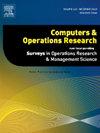The semi-online robotic pallet loading problem
IF 4.1
2区 工程技术
Q2 COMPUTER SCIENCE, INTERDISCIPLINARY APPLICATIONS
引用次数: 0
Abstract
The distributor’s online pallet loading problem (DPLP), which involves efficiently packing a set of cuboid boxes with various dimensions and unknown order into a minimum number of given sized pallet, is extensively employed in industrial automation and has recently garnered significant attention from the research community. However, the existing online approaches face challenges due to the unpredictable arrival order of boxes and the requirement for fast processing. To address this issue, we introduce a new variant of DPLP, the online pallet loading problem with buffer area, by introducing a buffer area with a predefined capacity within the stacking region. The arrival boxes are initially positioned within the buffer area until the total number of boxes reaches the maximum capacity of the buffer area, then, the boxes in the buffer area are selected and packed into the pallet. We propose a greedy search heuristic to solve the online DPLP with buffer area. Our approach uses an open space approach to represent the residual space and combine simple and guillotine blocks to generate blocks. By minimizing the amount of waste, we select the appropriate box placement. Extensive experimental tests on classical and practical instances shows that our method improves pallet utilization by more than 15% compared to purely online algorithms. Compared with other state-of-the-art algorithms, our method improves the average improvement by 8%. Moreover, our approach exhibits a certain level of generalizability and holds substantial practical value for real-world applications.
半在线机器人托盘装载问题
分销商在线托盘装载问题(DPLP)涉及将一组具有不同尺寸和未知顺序的长方体箱子有效地装入最小数量的给定尺寸托盘,该问题被广泛应用于工业自动化领域,最近引起了研究界的极大关注。然而,由于箱子到达顺序的不可预测性和快速处理的要求,现有的在线方法面临着挑战。为了解决这个问题,我们引入了 DPLP 的一个新变体,即带缓冲区的在线托盘装载问题,在堆叠区域内引入一个预定容量的缓冲区。到达的箱子最初被放置在缓冲区内,直到箱子总数达到缓冲区的最大容量,然后,缓冲区内的箱子被选中并装入托盘。我们提出了一种贪婪搜索启发式来求解带缓冲区的在线 DPLP。我们的方法使用开放空间法来表示剩余空间,并结合简单块和断头台块来生成块。通过最大限度地减少浪费,我们选择了合适的方块位置。在经典和实际案例中进行的大量实验测试表明,与纯在线算法相比,我们的方法提高了 15%以上的托盘利用率。与其他最先进的算法相比,我们的方法平均提高了 8%。此外,我们的方法还具有一定的通用性,在实际应用中具有很大的实用价值。
本文章由计算机程序翻译,如有差异,请以英文原文为准。
求助全文
约1分钟内获得全文
求助全文
来源期刊

Computers & Operations Research
工程技术-工程:工业
CiteScore
8.60
自引率
8.70%
发文量
292
审稿时长
8.5 months
期刊介绍:
Operations research and computers meet in a large number of scientific fields, many of which are of vital current concern to our troubled society. These include, among others, ecology, transportation, safety, reliability, urban planning, economics, inventory control, investment strategy and logistics (including reverse logistics). Computers & Operations Research provides an international forum for the application of computers and operations research techniques to problems in these and related fields.
 求助内容:
求助内容: 应助结果提醒方式:
应助结果提醒方式:


